TOYOTA AYGO X 2022 Owners Manual (in English)
Manufacturer: TOYOTA, Model Year: 2022, Model line: AYGO X, Model: TOYOTA AYGO X 2022Pages: 494, PDF Size: 92.53 MB
Page 331 of 494
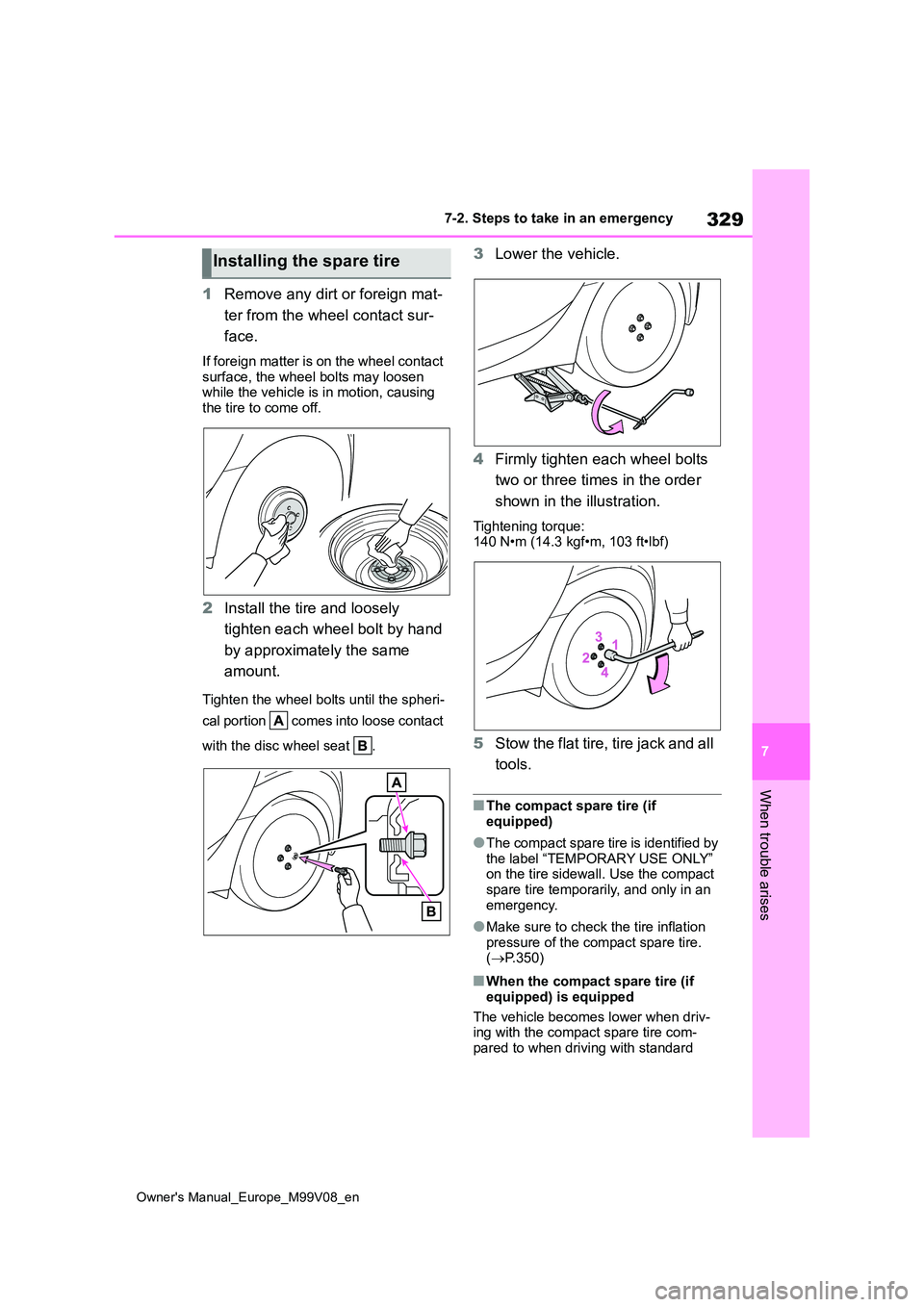
329
7
Owner's Manual_Europe_M99V08_en
7-2. Steps to take in an emergency
When trouble arises
1Remove any dirt or foreign mat-
ter from the wheel contact sur-
face.
If foreign matter is on the wheel contact
surface, the wheel bolts may loosen while the vehicle is in motion, causing the tire to come off.
2 Install the tire and loosely
tighten each wheel bolt by hand
by approximately the same
amount.
Tighten the wheel bolts until the spheri-
cal portion comes into loose contact
with the disc wheel seat .
3 Lower the vehicle.
4 Firmly tighten each wheel bolts
two or three times in the order
shown in the illustration.
Tightening torque: 140 N•m (14.3 kgf•m, 103 ft•lbf)
5 Stow the flat tire, tire jack and all
tools.
■The compact spare tire (if equipped)
●The compact spare tire is identified by the label “TEMPORARY USE ONLY” on the tire sidewall. Use the compact
spare tire temporarily, and only in an emergency.
●Make sure to check the tire inflation pressure of the compact spare tire. ( P.350)
■When the compact spare tire (if
equipped) is equipped
The vehicle becomes lower when driv- ing with the compact spare tire com-
pared to when driving with standard
Installing the spare tire
Page 332 of 494
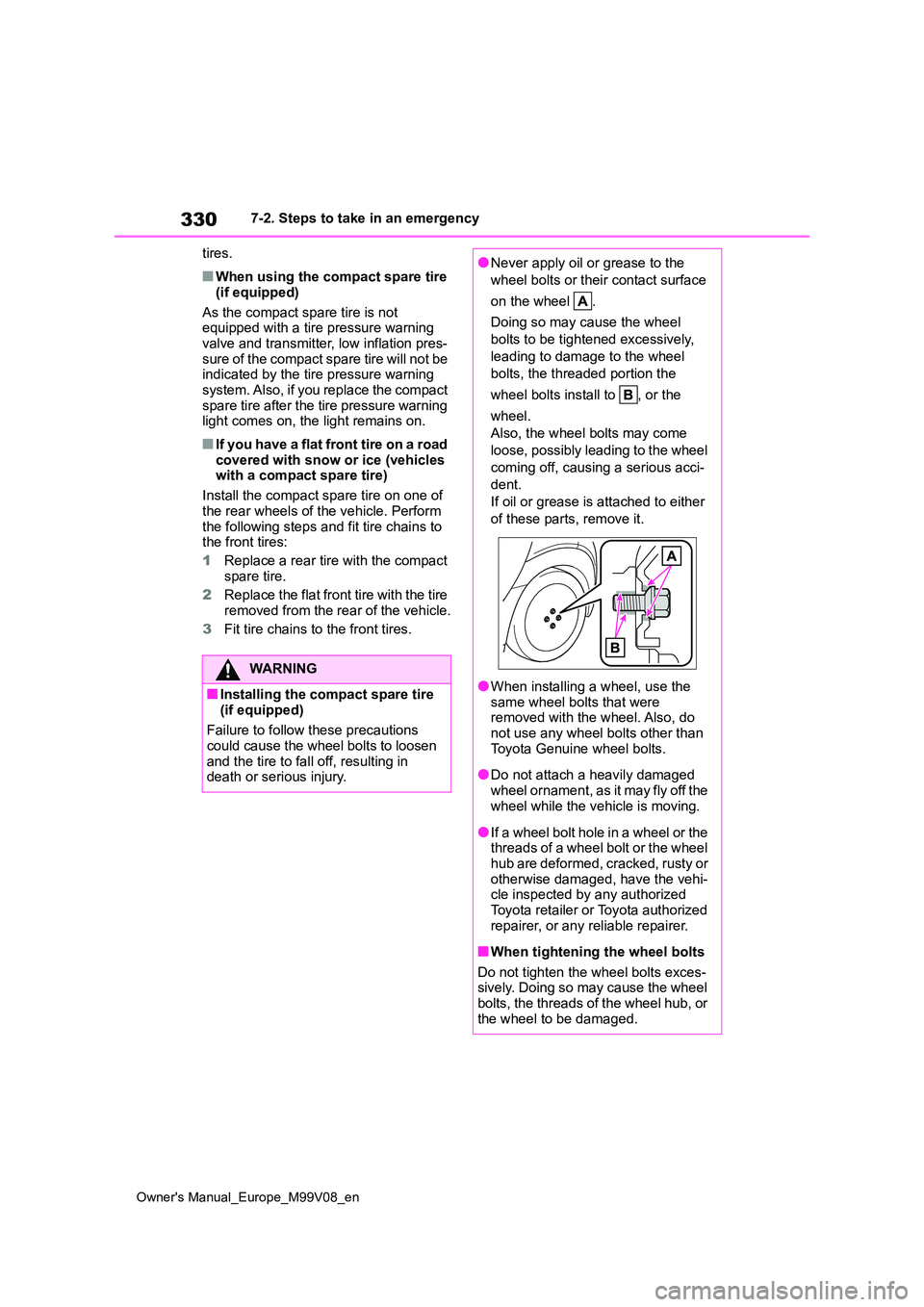
330
Owner's Manual_Europe_M99V08_en
7-2. Steps to take in an emergency
tires.
■When using the compact spare tire
(if equipped)
As the compact spare tire is not equipped with a tire pressure warning
valve and transmitter, low inflation pres- sure of the compact spare tire will not be indicated by the tire pressure warning
system. Also, if you replace the compact spare tire after the tire pressure warning light comes on, the light remains on.
■If you have a flat front tire on a road
covered with snow or ice (vehicles with a compact spare tire)
Install the compact spare tire on one of
the rear wheels of the vehicle. Perform the following steps and fit tire chains to the front tires:
1 Replace a rear tire with the compact
spare tire.
2 Replace the flat front tire with the tire removed from the rear of the vehicle.
3 Fit tire chains to the front tires.
WARNING
■Installing the compact spare tire
(if equipped)
Failure to follow these precautions could cause the wheel bolts to loosen
and the tire to fall off, resulting in death or serious injury.
●Never apply oil or grease to the
wheel bolts or their contact surface
on the wheel .
Doing so may cause the wheel
bolts to be tightened excessively,
leading to damage to the wheel
bolts, the threaded portion the
wheel bolts install to , or the
wheel.
Also, the wheel bolts may come
loose, possibly leading to the wheel
coming off, causing a serious acci-
dent.
If oil or grease is attached to either
of these parts, remove it.
●When installing a wheel, use the
same wheel bolts that were removed with the wheel. Also, do not use any wheel bolts other than
Toyota Genuine wheel bolts.
●Do not attach a heavily damaged
wheel ornament, as it may fly off the wheel while the vehicle is moving.
●If a wheel bolt hole in a wheel or the threads of a wheel bolt or the wheel hub are deformed, cracked, rusty or
otherwise damaged, have the vehi- cle inspected by any authorized Toyota retailer or Toyota authorized
repairer, or any reliable repairer.
■When tightening the wheel bolts
Do not tighten the wheel bolts exces- sively. Doing so may cause the wheel bolts, the threads of the wheel hub, or
the wheel to be damaged.
Page 333 of 494
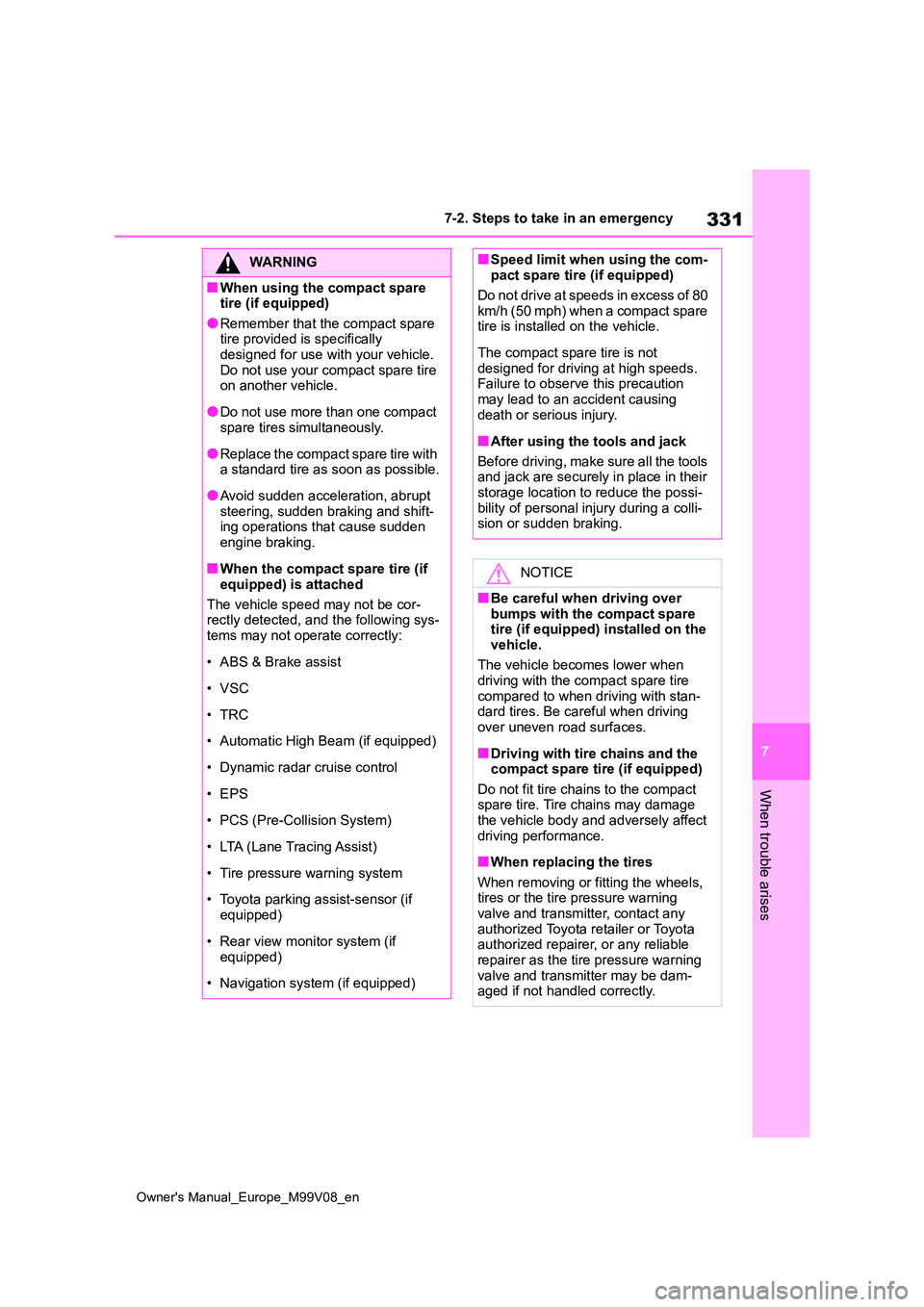
331
7
Owner's Manual_Europe_M99V08_en
7-2. Steps to take in an emergency
When trouble arises
WARNING
■When using the compact spare tire (if equipped)
●Remember that the compact spare tire provided is specifically designed for use with your vehicle.
Do not use your compact spare tire on another vehicle.
●Do not use more than one compact spare tires simultaneously.
●Replace the compact spare tire with a standard tire as soon as possible.
●Avoid sudden acceleration, abrupt steering, sudden braking and shift-ing operations that cause sudden
engine braking.
■When the compact spare tire (if
equipped) is attached
The vehicle speed may not be cor- rectly detected, and the following sys-
tems may not operate correctly:
• ABS & Brake assist
• VSC
•TRC
• Automatic High Beam (if equipped)
• Dynamic radar cruise control
• EPS
• PCS (Pre-Collision System)
• LTA (Lane Tracing Assist)
• Tire pressure warning system
• Toyota parking assist-sensor (if
equipped)
• Rear view monitor system (if
equipped)
• Navigation system (if equipped)
■Speed limit when using the com- pact spare tire (if equipped)
Do not drive at speeds in excess of 80
km/h (50 mph) when a compact spare tire is installed on the vehicle.
The compact spare tire is not designed for driving at high speeds. Failure to observe this precaution
may lead to an accident causing death or serious injury.
■After using the tools and jack
Before driving, make sure all the tools and jack are securely in place in their
storage location to reduce the possi- bility of personal injury during a colli-sion or sudden braking.
NOTICE
■Be careful when driving over bumps with the compact spare tire (if equipped) installed on the
vehicle.
The vehicle becomes lower when driving with the compact spare tire
compared to when driving with stan- dard tires. Be careful when driving over uneven road surfaces.
■Driving with tire chains and the compact spare tire (if equipped)
Do not fit tire chains to the compact spare tire. Tire chains may damage the vehicle body and adversely affect
driving performance.
■When replacing the tires
When removing or fitting the wheels, tires or the tire pressure warning valve and transmitter, contact any
authorized Toyota retailer or Toyota authorized repairer, or any reliable repairer as the tire pressure warning
valve and transmitter may be dam- aged if not handled correctly.
Page 334 of 494
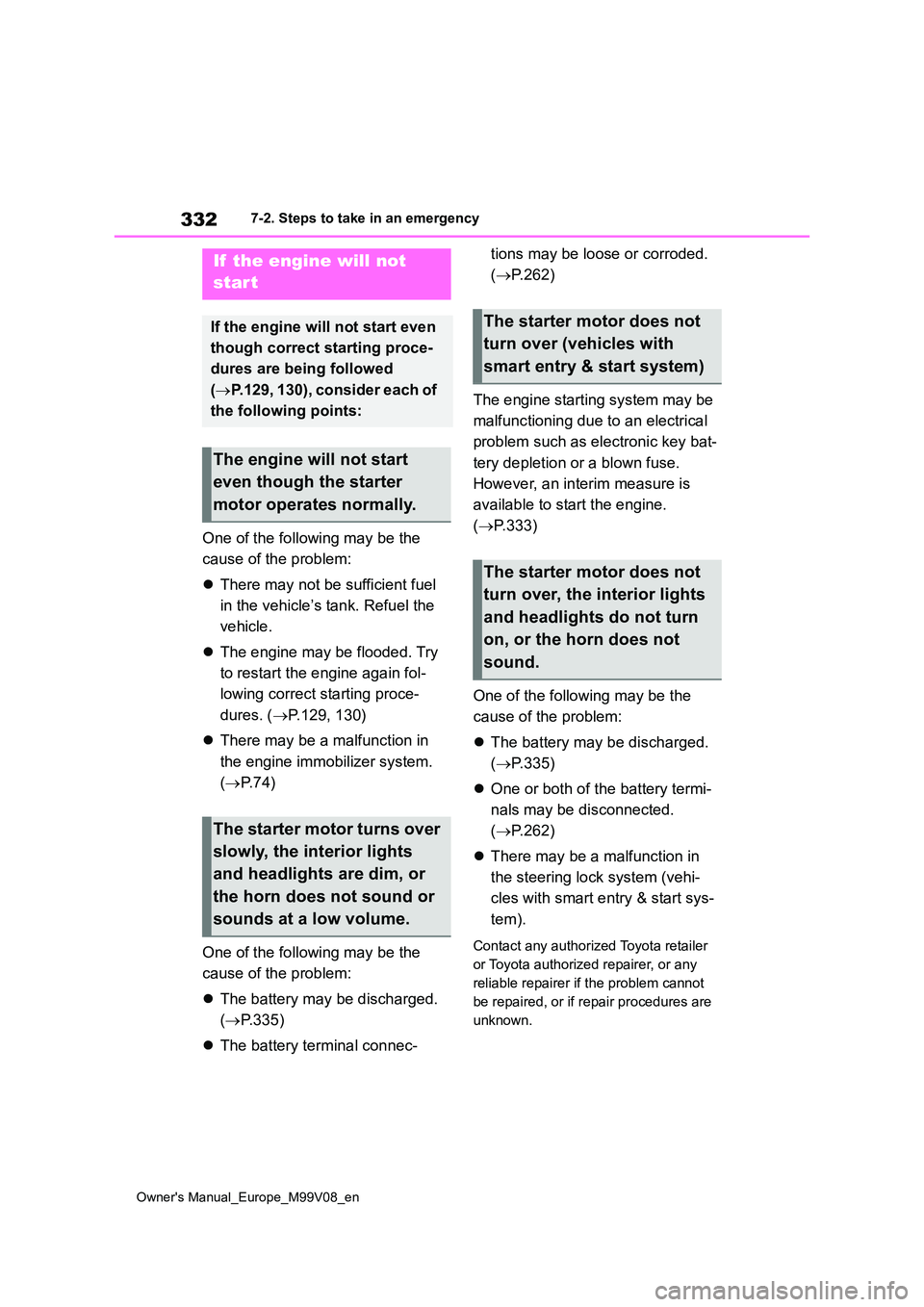
332
Owner's Manual_Europe_M99V08_en
7-2. Steps to take in an emergency
One of the following may be the
cause of the problem:
There may not be sufficient fuel
in the vehicle’s tank. Refuel the
vehicle.
The engine may be flooded. Try
to restart the engine again fol-
lowing correct starting proce-
dures. ( P.129, 130)
There may be a malfunction in
the engine immobilizer system.
( P. 7 4 )
One of the following may be the
cause of the problem:
The battery may be discharged.
( P.335)
The battery terminal connec-
tions may be loose or corroded.
( P.262)
The engine starting system may be
malfunctioning due to an electrical
problem such as electronic key bat-
tery depletion or a blown fuse.
However, an interim measure is
available to start the engine.
( P.333)
One of the following may be the
cause of the problem:
The battery may be discharged.
( P.335)
One or both of the battery termi-
nals may be disconnected.
( P.262)
There may be a malfunction in
the steering lock system (vehi-
cles with smart entry & start sys-
tem).
Contact any authorized Toyota retailer
or Toyota authorized repairer, or any
reliable repairer if the problem cannot
be repaired, or if repair procedures are
unknown.
If the engine will not
start
If the engine will not start even
though correct starting proce-
dures are being followed
( P.129, 130), consider each of
the following points:
The engine will not start
even though the starter
motor operates normally.
The starter motor turns over
slowly, the interior lights
and headlights are dim, or
the horn does not sound or
sounds at a low volume.
The starter motor does not
turn over (vehicles with
smart entry & start system)
The starter motor does not
turn over, the interior lights
and headlights do not turn
on, or the horn does not
sound.
Page 335 of 494
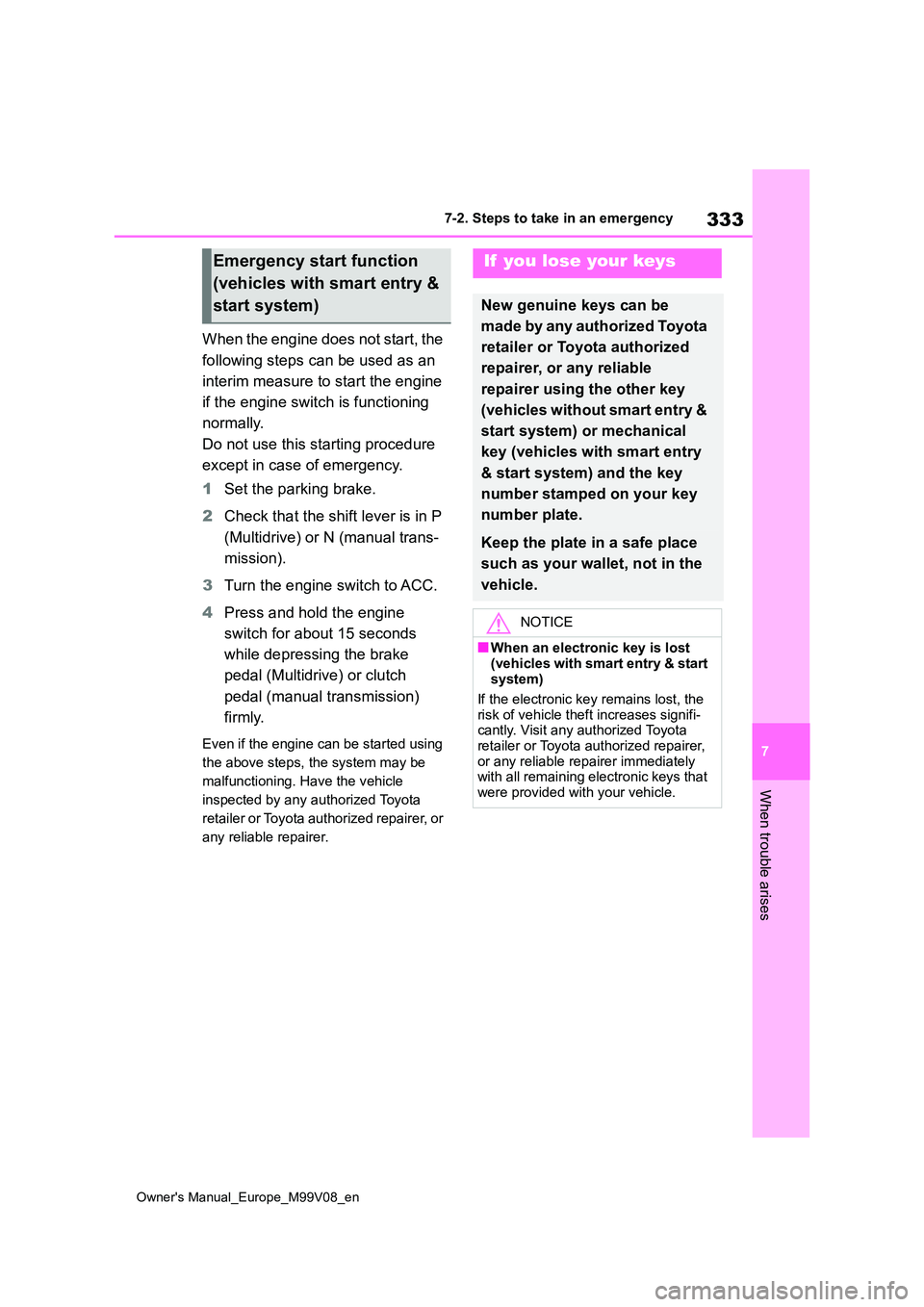
333
7
Owner's Manual_Europe_M99V08_en
7-2. Steps to take in an emergency
When trouble arises
When the engine does not start, the
following steps can be used as an
interim measure to start the engine
if the engine switch is functioning
normally.
Do not use this starting procedure
except in case of emergency.
1 Set the parking brake.
2 Check that the shift lever is in P
(Multidrive) or N (manual trans-
mission).
3 Turn the engine switch to ACC.
4 Press and hold the engine
switch for about 15 seconds
while depressing the brake
pedal (Multidrive) or clutch
pedal (manual transmission)
firmly.
Even if the engine can be started using
the above steps, the system may be
malfunctioning. Have the vehicle
inspected by any authorized Toyota
retailer or Toyota authorized repairer, or
any reliable repairer.
Emergency start function
(vehicles with smart entry &
start system)
If you lose your keys
New genuine keys can be
made by any authorized Toyota
retailer or Toyota authorized
repairer, or any reliable
repairer using the other key
(vehicles without smart entry &
start system) or mechanical
key (vehicles with smart entry
& start system) and the key
number stamped on your key
number plate.
Keep the plate in a safe place
such as your wallet, not in the
vehicle.
NOTICE
■When an electronic key is lost
(vehicles with smart entry & start system)
If the electronic key remains lost, the
risk of vehicle theft increases signifi- cantly. Visit any authorized Toyota retailer or Toyota authorized repairer,
or any reliable repairer immediately with all remaining electronic keys that were provided with your vehicle.
Page 336 of 494
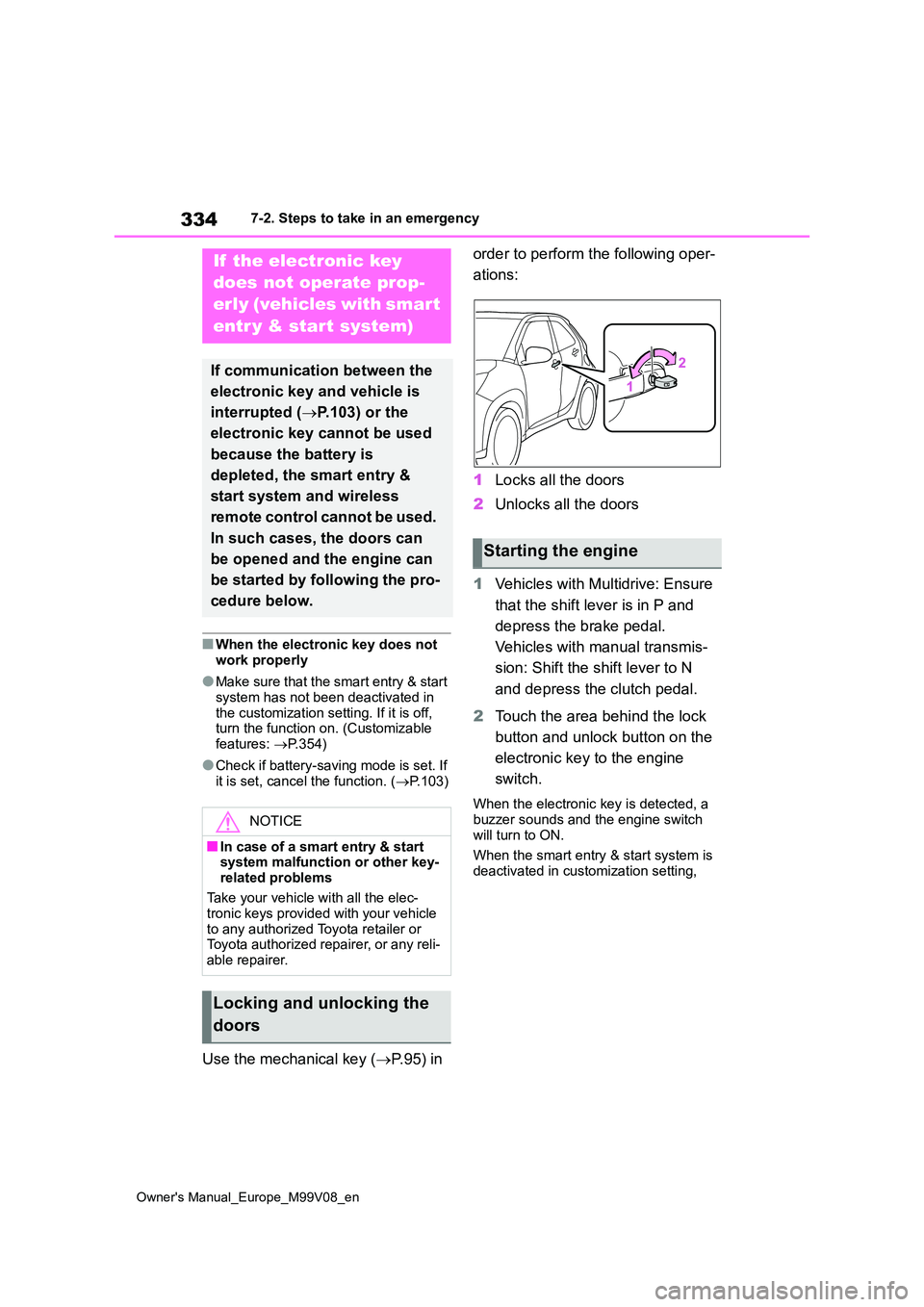
334
Owner's Manual_Europe_M99V08_en
7-2. Steps to take in an emergency
■When the electronic key does not
work properly
●Make sure that the smart entry & start
system has not been deactivated in the customization setting. If it is off, turn the function on. (Customizable
features: P.354)
●Check if battery-saving mode is set. If
it is set, cancel the function. ( P.103)
Use the mechanical key (P.95) in
order to perform the following oper-
ations:
1 Locks all the doors
2 Unlocks all the doors
1 Vehicles with Multidrive: Ensure
that the shift lever is in P and
depress the brake pedal.
Vehicles with manual transmis-
sion: Shift the shift lever to N
and depress the clutch pedal.
2 Touch the area behind the lock
button and unlock button on the
electronic key to the engine
switch.
When the electronic key is detected, a
buzzer sounds and the engine switch will turn to ON.
When the smart entry & start system is
deactivated in customization setting,
If the electronic key
does not operate prop-
erly (vehicles with smart
entr y & start system)
If communication between the
electronic key and vehicle is
interrupted ( P.103) or the
electronic key cannot be used
because the battery is
depleted, the smart entry &
start system and wireless
remote control cannot be used.
In such cases, the doors can
be opened and the engine can
be started by following the pro-
cedure below.
NOTICE
■In case of a smart entry & start system malfunction or other key-
related problems
Take your vehicle with all the elec- tronic keys provided with your vehicle
to any authorized Toyota retailer or Toyota authorized repairer, or any reli-able repairer.
Locking and unlocking the
doors
Starting the engine
Page 337 of 494
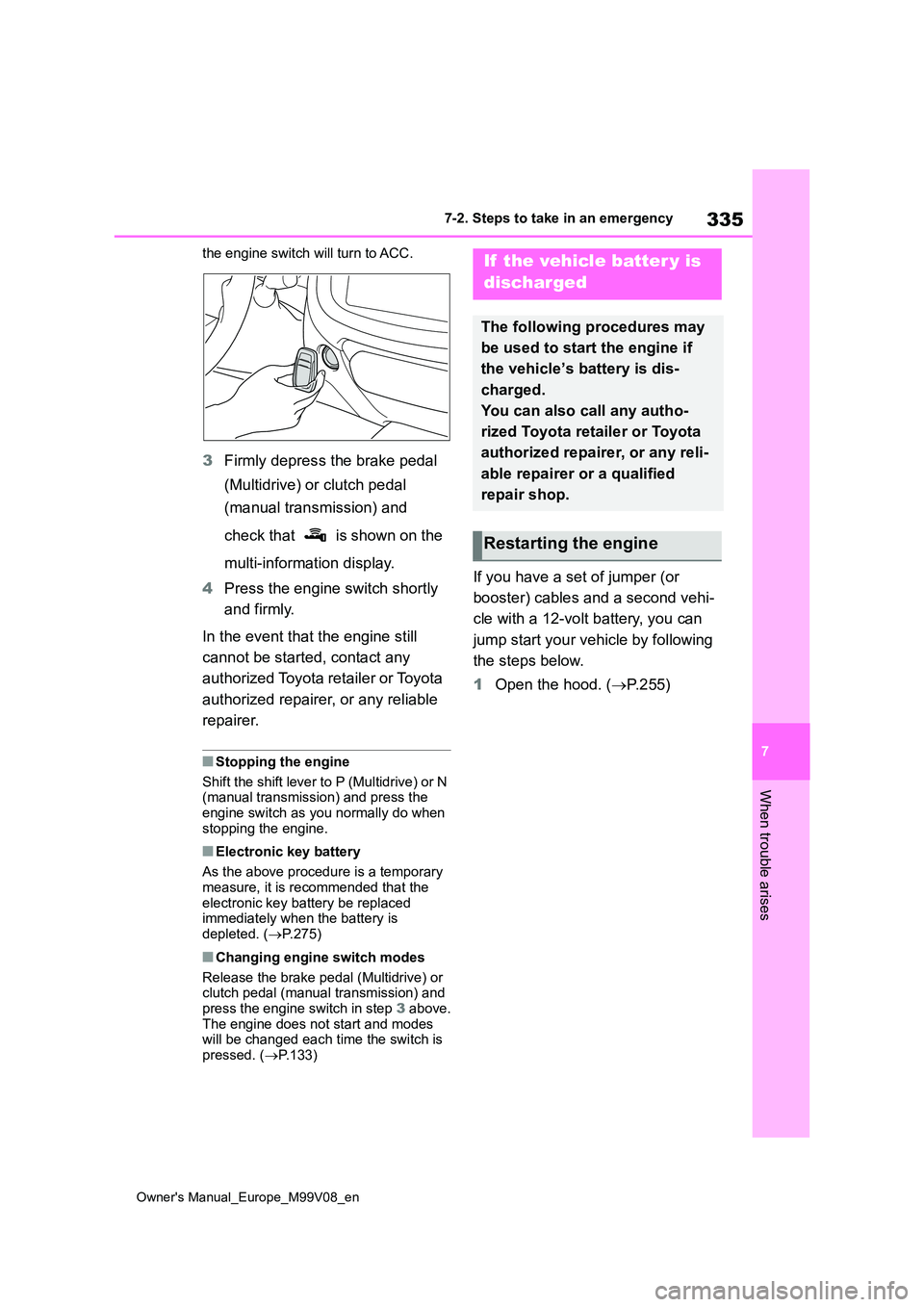
335
7
Owner's Manual_Europe_M99V08_en
7-2. Steps to take in an emergency
When trouble arises
the engine switch will turn to ACC.
3Firmly depress the brake pedal
(Multidrive) or clutch pedal
(manual transmission) and
check that is shown on the
multi-information display.
4 Press the engine switch shortly
and firmly.
In the event that the engine still
cannot be started, contact any
authorized Toyota retailer or Toyota
authorized repairer, or any reliable
repairer.
■Stopping the engine
Shift the shift lever to P (Multidrive) or N (manual transmission) and press the
engine switch as you normally do when stopping the engine.
■Electronic key battery
As the above procedure is a temporary
measure, it is recommended that the electronic key battery be replaced immediately when the battery is
depleted. ( P.275)
■Changing engine switch modes
Release the brake pedal (Multidrive) or clutch pedal (manual transmission) and
press the engine switch in step 3 above. The engine does not start and modes will be changed each time the switch is
pressed. ( P.133)
If you have a set of jumper (or
booster) cables and a second vehi-
cle with a 12-volt battery, you can
jump start your vehicle by following
the steps below.
1 Open the hood. (P.255)
If the vehicle batter y is
discharged
The following procedures may
be used to start the engine if
the vehicle’s battery is dis-
charged.
You can also call any autho-
rized Toyota retailer or Toyota
authorized repairer, or any reli-
able repairer or a qualified
repair shop.
Restarting the engine
Page 338 of 494

336
Owner's Manual_Europe_M99V08_en
7-2. Steps to take in an emergency
2Connect a positive jumper cable clamp to on your vehicle and con-
nect the clamp on the other end of the positive cable to on th e sec-
ond vehicle. Then, connect a negative cable clamp to on the se cond
vehicle and connect the clamp at the other end of the negative cable to
.
Positive (+) battery terminal (your vehicle)
Positive (+) battery terminal (second vehicle)
Negative (-) battery terminal (second vehicle)
Solid, stationary, unpainted metallic point away from the batte ry and any
moving parts as shown in the illustration
3 Start the engine of the second
vehicle. Increase the engine
speed slightly and maintain at
that level for approximately 5
minutes to recharge the battery
of your vehicle.
4 Vehicles with smart entry & start
system: Open and close any of
the doors of your vehicle with
the engine switch OFF.
5 Maintain the engine speed of
the second vehicle and start the
engine of your vehicle by turning
the engine switch to ON.
6 Once the vehicle’s engine has
started, remove the jumper
cables in the exact reverse
order from which they were con-
nected.
Once the engine starts, have the
vehicle inspected at any autho-
rized Toyota retailer or Toyota
authorized repairer, or any reliable
repairer as soon as possible.
Page 339 of 494
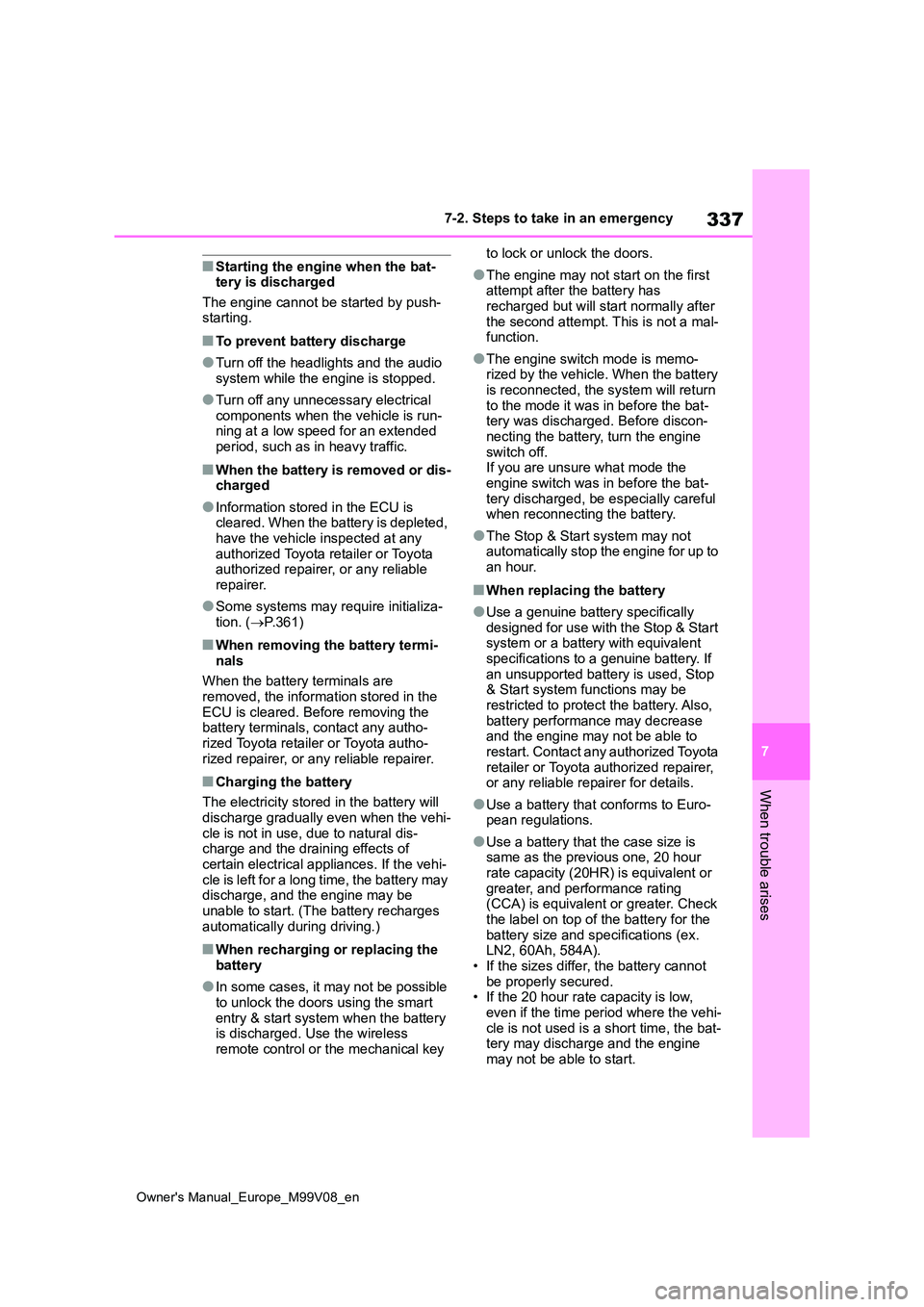
337
7
Owner's Manual_Europe_M99V08_en
7-2. Steps to take in an emergency
When trouble arises
■Starting the engine when the bat- tery is discharged
The engine cannot be started by push- starting.
■To prevent battery discharge
●Turn off the headlights and the audio system while the engine is stopped.
●Turn off any unnecessary electrical components when the vehicle is run-ning at a low speed for an extended
period, such as in heavy traffic.
■When the battery is removed or dis- charged
●Information stored in the ECU is cleared. When the battery is depleted, have the vehicle inspected at any
authorized Toyota retailer or Toyota authorized repairer, or any reliable repairer.
●Some systems may require initializa-tion. ( P.361)
■When removing the battery termi-
nals
When the battery terminals are removed, the information stored in the
ECU is cleared. Before removing the battery terminals, contact any autho-rized Toyota retailer or Toyota autho-
rized repairer, or any reliable repairer.
■Charging the battery
The electricity stored in the battery will
discharge gradually even when the vehi- cle is not in use, due to natural dis-charge and the draining effects of
certain electrical appliances. If the vehi- cle is left for a long time, the battery may discharge, and the engine may be
unable to start. (The battery recharges automatically during driving.)
■When recharging or replacing the battery
●In some cases, it may not be possible to unlock the doors using the smart
entry & start system when the battery is discharged. Use the wireless remote control or the mechanical key
to lock or unlock the doors.
●The engine may not start on the first attempt after the battery has
recharged but will start normally after the second attempt. This is not a mal-function.
●The engine switch mode is memo-rized by the vehicle. When the battery
is reconnected, the system will return to the mode it was in before the bat-tery was discharged. Before discon-
necting the battery, turn the engine switch off.If you are unsure what mode the
engine switch was in before the bat- tery discharged, be especially careful when reconnecting the battery.
●The Stop & Start system may not automatically stop the engine for up to
an hour.
■When replacing the battery
●Use a genuine battery specifically
designed for use with the Stop & Start system or a battery with equivalent specifications to a genuine battery. If
an unsupported battery is used, Stop & Start system functions may be restricted to protect the battery. Also,
battery performance may decrease and the engine may not be able to restart. Contact any authorized Toyota
retailer or Toyota authorized repairer, or any reliable repairer for details.
●Use a battery that conforms to Euro-pean regulations.
●Use a battery that the case size is same as the previous one, 20 hour rate capacity (20HR) is equivalent or
greater, and performance rating (CCA) is equivalent or greater. Check the label on top of the battery for the
battery size and specifications (ex. LN2, 60Ah, 584A).• If the sizes differ, the battery cannot
be properly secured. • If the 20 hour rate capacity is low, even if the time period where the vehi-
cle is not used is a short time, the bat- tery may discharge and the engine may not be able to start.
Page 340 of 494

338
Owner's Manual_Europe_M99V08_en
7-2. Steps to take in an emergency
●For details, consult any authorized
Toyota retailer or Toyota authorized repairer, or any reliable repairer.
WARNING
■When removing the battery ter-
minals
Always remove the negative (-) termi- nal first. If the positive (+) terminal
contacts any metal in the surrounding area when the positive (+) terminal is removed, a spark may occur, leading
to a fire in addition to electrical shocks and death or serious injury.
■Avoiding battery fires or explo-sions
Observe the following precautions to
prevent accidentally igniting the flam- mable gas that may be emitted from the battery:
●Make sure each jumper cable is connected to the correct terminal
and that it is not unintentionally in contact with any other than the intended terminal.
●Do not allow the other end of the jumper cable connected to the “+”
terminal to come into contact with any other parts or metal surfaces in the area, such as brackets or
unpainted metal.
●Do not allow the + and - clamps of
the jumper cables to come into con- tact with each other.
●Do not smoke, use matches, ciga-rette lighters or allow open flame near the battery.
■Battery precautions
The battery contains poisonous and
corrosive acidic electrolyte, while related parts contain lead and lead compounds. Observe the following
precautions when handling the bat- tery:
●When working with the battery, always wear safety glasses and take care not to allow any battery
fluids (acid) to come into contact with skin, clothing or the vehicle body.
●Do not lean over the battery.
●In the event that battery fluid comes into contact with the skin or eyes, immediately wash the affected area
with water and seek medical atten- tion. Place a wet sponge or cloth over the affected area until medical
attention can be received.
●Always wash your hands after han-
dling the battery support, terminals, and other battery-related parts.
●Do not allow children near the bat-tery.
■When replacing the battery
●When the vent plug and indicator are close to the hold down clamp,
the battery fluid (sulfuric acid) may leak.
●For information regarding battery replacement, contact any autho-rized Toyota retailer or Toyota
authorized repairer, or any reliable repairer.
NOTICE
■When handling jumper cables
When connecting the jumper cables, ensure that they do not become entangled in the cooling fan or engine
drive belt.